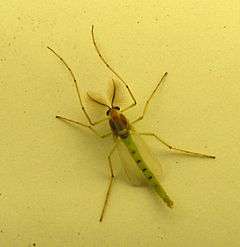Axarus
The genus Axarus is widely distributed with records from the Holarctic, the Neotropics and Australasia .[1][2] There are currently 5 described nearctic species .[3] Erected as a subgenus (Anceus) of Xenochironomus ,[4] Axarus was subsequently renamed and elevated to generic status .[5] The Connecticut River in the eastern United States harbors locally dense populations of two Axarus species, both currently undescribed. These populations are interesting in that they are restricted to specific larval habitat (varve clay and sometimes rotting wood) and thus there is genetic structure between populations in the river .[6] The Connecticut River species are also notable in that they have extremely well developed polytene chromosomes and also maintain a high degree of inversion polymorphism .[7][8]
| Axarus | |
|---|---|
 | |
| Scientific classification | |
| Kingdom: | |
| Phylum: | |
| Class: | |
| Order: | |
| Suborder: | |
| Infraorder: | |
| Superfamily: | |
| Family: | |
| Subfamily: | |
| Tribe: | |
| Genus: | Axarus Roback, 1980 |
Species
- A. dorneri (Malloch, 1915)
- A. festivus Say, 1823
- A. rogersi (Beck and Beck, 1958)
- A. scopula (Townes, 1945)
- A. taenionotus (Say, 1829)
References
- Andersen, T. & H. F. Mendes (2002). "New species and records of the Axarus "rogersi-group" from South and Central America (Diptera, Chironomidae)". Acta Zoologica Academiae Scientiarum Hungaricae. 48: 35–40.
- Cranston, P. S.; M. E. Dillon; L. C. V. Pinder & F. Reiss (1989). "The Adult Males of Chironominae (Diptera, Chironomidae) of the Holarctic Region - Keys and Diagnoses". Ent. Scand. Supp. 34: 353–502.
- Townes, H. K. (1945). "The nearctic species of Tendipedini (Diptera, Tendipedidae (= Chironomidae))". American Midland Naturalist. 34 (1): 1–206. doi:10.2307/2421112. JSTOR 2421112.
- Roback, S. S. (1963). "The genus Xenochironomus (Diptera: Tendipedidae) Kieffer, taxonomy and immature stages". Trans. Am. Entomol. Soc. 88: 235–245.
- Roback, S. S. (1980). "New name for Anceus Roback nec Anceus Risso". Entomological News. 91: 32.
- Werle, S. F. (2005). "Populations of a Connecticut River midge structured by geological history and downstream gene flow". Chromosome Research. 13 (1): 97–106. doi:10.1007/s10577-005-2358-6. PMID 15791415.
- Werle, S. F.; E. Klekowski & D. G. Smith (2004). "Inversion polymorphism in a Connecticut River Axarus species (Diptera: Chironomidae): biometric effects of a triple inversion heterozygote". Can. J. Zool. 82: 118–129. doi:10.1139/z03-227.
- Werle, S. F.; D. G. Smith & E. Klekowski (2004). "Life in Crumbling Clay: The Biology of Axarus Species (Diptera: Chironomidae) in the Connecticut River". Northeastern Naturalist. 11 (4): 443–458. doi:10.1656/1092-6194(2004)011[0443:LICCTB]2.0.CO;2.